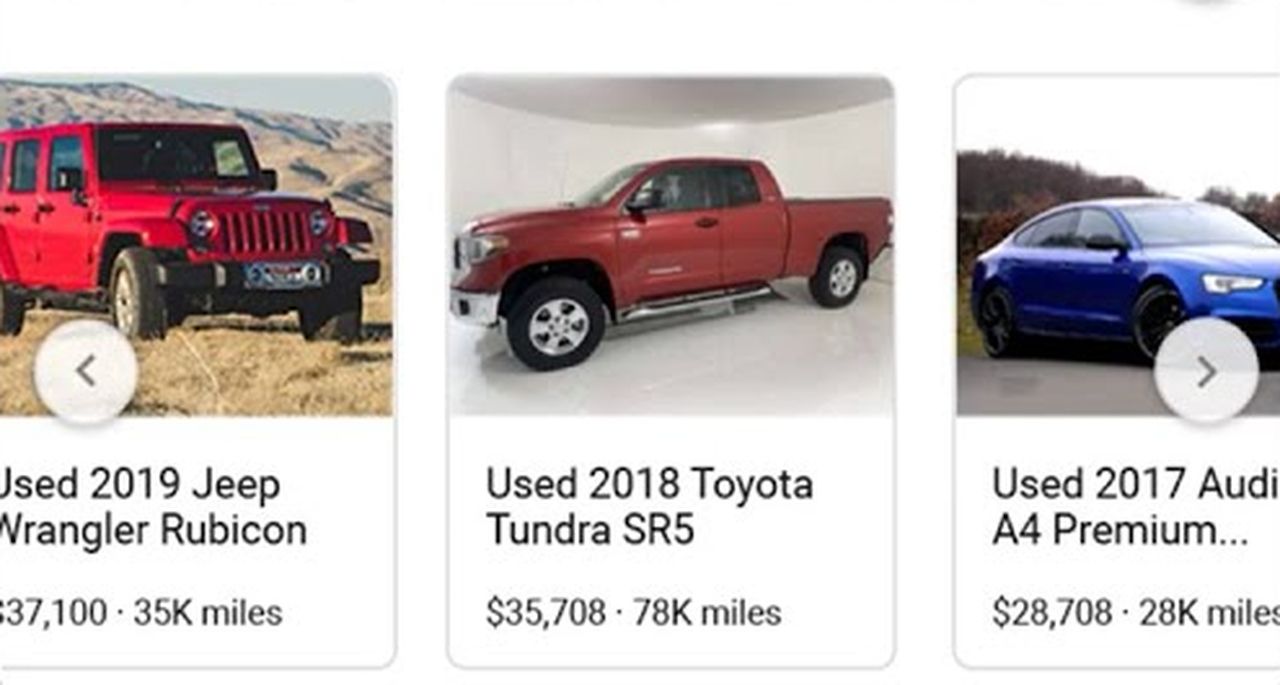Structured data for vehicle listings, especially for cars, has become a critical component in the online automotive marketplace.
This structured data allows search engines and other online platforms to better understand the information about vehicles listed for sale, which, in turn, enhances the way these listings are displayed in search results and on various platforms.
What is Vehicle Listing Structured Data?
Vehicle listing structured data is a specific type of schema markup that provides search engines and other platforms with detailed information about a car that is listed for sale.
This information includes various attributes such as make, model, year, price, mileage, and more.
By using structured data, you can help search engines understand the specifics of your vehicle listings and present this information in a more structured and appealing way to users.
Why Is Vehicle Listing Structured Data Important?
- Enhanced Visibility: Using structured data for your car listings can significantly improve your listings' visibility in search engine results. When you mark up your listings, search engines can understand and display this information more effectively, potentially leading to higher click-through rates.
- Rich Results: Structured data enables your car listings to appear as rich results in search engine listings. Rich results include additional information such as images, prices, and reviews, making your listings more eye-catching to potential buyers.
- Increased Relevance: By providing detailed information about your vehicles, you ensure that your listings are displayed to users who are actively looking for the specific type of car you're selling, increasing the relevance of your listings.
Vehicle Listing Rich Result Feature Availability
The vehicle listing rich result feature is currently only available in English in the United States and its territories. This feature is accessible on both mobile and desktop devices.

Two Methods for Providing Inventory Data to Google
Car dealerships have two primary methods for providing their car inventory data to Google. These methods enable the display of car inventory information on various Google platforms:
Structured Data Markup
- Relatively easy to implement and maintain structured data markup on websites.
- Changes on websites may take longer for Google to detect.
- No 1:1 support is provided for issues with structured data markup.
Feed File Uploads
- Requires system development to create and maintain feed files.
- All inventory data in feed files is recognized by Google.
- 1:1 support is available through the vehicle listings partner portal to address any issues with feed uploads.
- Feeds support more detailed properties for vehicle inventory.
How to Add Structured Data to Your Web Page
Structured data is a standardized format for providing information about a web page and classifying its content. Here's a general overview of the steps to build, test, and release structured data on your web page. For a more detailed, step-by-step guide, consider the structured data codelab.
1. Add the Required Properties:
Depending on the format you're using, determine where to insert structured data on your web page.
2. Follow the Guidelines:
Adhere to Google's structured data guidelines for the specific content you're marking up. These guidelines help ensure your structured data is accurately interpreted by search engines.
3. Validate Your Code:
Use the Rich Results Test to validate your structured data. Address any critical errors that are identified by the tool.
Consider fixing non-critical issues as well, as this can enhance the quality of your structured data. While not mandatory for eligibility for rich results, it's beneficial.
4. Deploy Structured Data:
Implement structured data on a few web pages. Make sure these pages are accessible to Google and not blocked by factors such as a robots.txt file, the noindex tag, or login requirements.
After adding structured data, use the URL Inspection tool to test how Google sees the page. Ensure that the page appears correctly and contains the structured data as expected.
5. Request Google to Recrawl URLs:
If the page with structured data looks okay in the URL Inspection tool, you can ask Google to recrawl your URLs.
Keep in mind that it may take several days for Google to discover, crawl, and index your page after publishing.
6. Submit a Sitemap:
To keep Google informed of future changes and new content, consider submitting a sitemap.
You can automate this process using the Search Console Sitemap API, which helps Google understand your site's structure and content more efficiently.
By following these steps and ensuring your structured data is accurate and compliant with guidelines, you can enhance your web page's visibility and eligibility for rich results in search engine results pages.
Guidelines and Eligibility Requirements for Displaying Car Inventory on Google
To display car inventory data on Google surfaces, dealerships must meet specific eligibility requirements:
Claimed and Verified Business Profile:
- The dealership must have a claimed and verified Business Profile on Google.
- This applies to businesses located in the United States or its territories.
Business Profile Type:
- The Business Profile must be categorized under the "vehicle_dealer" Place type.
Dealer-Owned Vehicle Inventory:
- Dealerships are only allowed to include vehicle inventory that they own and are selling directly.
- Listings for vehicles from private sellers, individuals, or auto brokers are not permitted.
Geographic Restriction:
- Dealerships can only include vehicle inventory for cars that are available for sale within the United States or its territories.
By adhering to these guidelines and eligibility requirements, car dealerships can ensure that their car inventory data is eligible for display on Google's various surfaces, providing valuable information to potential customers.

Structured Data Type Definitions for Car Listings
Structured data for car listings provides detailed information about vehicles for sale, making them eligible for display in vehicle listing rich results.
Required Properties
Brand
- Information about the make of the vehicle.
- brand.name: The name of the vehicle make, e.g., "Toyota."
Item Condition
- Specifies whether the vehicle is new or used.
- NewCondition: The vehicle is new.
- UsedCondition: The vehicle is used (not new).
Mileage From Odometer
- Information about the total distance traveled by the vehicle since its production.
- mileageFromOdometer.unitCode: The unit of distance (e.g., miles or kilometers).
- mileageFromOdometer.value: The numerical value of the distance (excluding new vehicles with over 20,000 miles).
Model
- The model of the vehicle (excluding trim specifics).
- model: e.g., "Civic."
Offers
- Offer details about the vehicle for sale.
- offers.availability: Availability of the vehicle (InStock or OutOfStock).
- offers.price: The final sale price.
- offers.priceCurrency: Currency of the sale price.
Vehicle Identification Number (VIN)
- Unique alphanumeric identifier for the vehicle. (Note: Some restrictions apply.)
Vehicle Model Date
The model year in YYYY format.
Recommended Properties
Body Type
- The body style of the vehicle.
- bodyType: e.g., sedan, suv, or crossover.
Color
- The OEM-specified exterior color.
- color: e.g., White, Platinum, or Metallic Tri-Coat.
Drive Wheel Configuration
- The configuration of the vehicle's drive wheels.
- driveWheelConfiguration: Choose from AllWheelDriveConfiguration, FourWheelDriveConfiguration, FrontWheelDriveConfiguration, or RearWheelDriveConfiguration.
Image
- Image(s) of the vehicle (must meet Google's image policies).
- image: URL or ImageObject.
Name
- The displayed name of the vehicle on the website.
- name: e.g., "Used 2020 BMW 530i w/ Convenience Package."
Number of Doors
- The count of doors in the vehicle.
URL
- Link to the dealer's Vehicle Details Page (VDP).
Vehicle Configuration
- The trim of the model, e.g., S, SV, or SL.
Vehicle Engine
- Information about the vehicle's engine specification.
- vehicleEngine.fuelType: Fuel type suitable for the engine.
Vehicle Interior Color
- The OEM-specified interior color.
Vehicle Interior Type
- Material or type of the interior (e.g., synthetic fabric, leather, wood).
Vehicle Seating Capacity
- The number of seats in the vehicle.
Vehicle Transmission
- The transmission specification (e.g., 9-speed automatic or manual).
These structured data properties provide detailed information about car listings, making them eligible for display in vehicle listing rich results on Google.
Example
<html>
<head>
<title>1999 Toyota Corolla LE</title>
<script type="application/ld+json">
{
"@context": "https://schema.org",
"@type": "Car",
"name": "1999 Toyota Corolla LE",
"vehicleIdentificationNumber": "1NXBR14E7XZ100000",
"image": [
"https://example.com/image1.png",
"https://example.com/image2.png"
],
"url": "https://www.example.com/used-vehicle-1999-toyota-corolla-le-c-67/",
"offers": {
"@type": "Offer",
"availability": "https://schema.org/InStock",
"price": 5000,
"priceCurrency": "USD"
},
"itemCondition": "https://schema.org/NewCondition",
"brand": {
"@type": "Brand",
"name": "Toyota"
},
"model": "Corolla",
"vehicleConfiguration": "LE",
"vehicleModelDate": "1999",
"mileageFromOdometer": {
"@type": "QuantitativeValue",
"value": "100000",
"unitCode": "SMI"
},
"color": "Red",
"vehicleInteriorColor": "Black",
"vehicleInteriorType": "Standard",
"bodyType": "Sedan",
"driveWheelConfiguration": "https://schema.org/FourWheelDriveConfiguration",
"vehicleEngine": {
"@type": "EngineSpecification",
"fuelType": "Gasoline"
},
"vehicleTransmission": "Automatic",
"numberOfDoors": 4,
"vehicleSeatingCapacity": 5
}
</script>
</head>
<body>
</body>
Monitoring Rich Results with Search Console
Search Console is a valuable tool for tracking the performance of your web pages in Google Search. While inclusion in Google Search results doesn't require signing up for Search Console, it can provide insights to help you understand and enhance how Google views your website. Here are situations where we recommend using Search Console:
1. After Implementing Structured Data for the First Time
- Once you've deployed structured data on your site and Google has indexed your pages, it's important to check for issues using the relevant Rich Result Status report.
- Ideally, you should observe an increase in valid items and no increase in invalid items. If you encounter issues with your structured data:
- Address and fix the invalid items.
- Inspect a live URL to ensure the problem is resolved.
- Request validation using the status report.
2. After Releasing New Templates or Updating Your Code
- When you make significant changes to your website, closely monitor for any uptick in the number of structured data invalid items.
- If you notice an increase in invalid items, it could be due to a new template that's not functioning correctly or your site interacting with the existing template in an unintended way.
- If you observe a decrease in valid items without a corresponding increase in invalid items, it might indicate that structured data is no longer embedded in your pages. Use the URL Inspection tool to diagnose the issue.
3. Periodic Analysis of Traffic
- Periodically analyze your Google Search traffic by using the Performance Report. This data will provide insights into how frequently your pages appear as rich results in Search, user click-through rates, and your average position in search results.
- You can also automatically access and retrieve this data using the Search Console API.
By monitoring your site's performance with Search Console in these scenarios, you can identify issues, enhance your structured data, and optimize your web pages for improved visibility and user engagement in Google Search results.
Conclusion
In summary, structured data for vehicle listings is vital in the online automotive marketplace. It enhances the visibility and presentation of car listings in search results, leading to higher click-through rates and increased relevance for potential buyers.
Car dealerships can provide their inventory data to Google through structured data markup or feed file uploads, depending on their specific needs.
Adding structured data involves following a series of steps, including adding required properties, adhering to Google's guidelines, validating your code, deploying structured data, and requesting Google to recrawl URLs, as well as submitting a sitemap. This process enhances a web page's visibility and eligibility for rich results.
Structured data properties for car listings include required and recommended attributes, providing detailed information about the make, model, condition, price, and more, making the listings eligible for display in vehicle listing rich results.
Monitoring rich results with Google Search Console is essential to track structured data performance and resolve any issues, providing valuable insights to enhance your web pages' visibility and user engagement in Google Search results.


